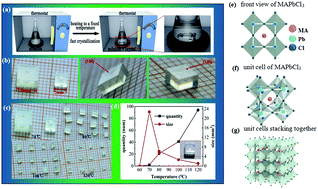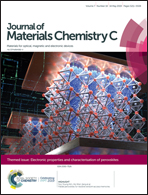A high performance perovskite CH3NH3PbCl3 single crystal photodetector: benefiting from an evolutionary preparation process†
Abstract
Hybrid organic–inorganic lead halide perovskites (CH3NH3PbX3, X = Cl, Br, or I) are deemed to be the highest potential semiconducting materials due to their unique optoelectronic properties. Nowadays, most perovskite photodetectors are fabricated on the basis of thin films, and their performances are limited by the low carrier mobility and high trap density of the thin films. Herein, a high performance photodetector was fabricated via a method involving inversion temperature precision gradient crystallization (ITPGC) for the first time, which is an improvement on traditional methods. The structure of the bulk single crystal is confirmed via XRD and TEM characterization. Also, in terms of nucleation and growth theory, the growth mechanism is explained in detail and the best growth temperature is suggested to be 80 °C for the first time. Benefiting from this, a photodetector with ultra-high responsivity of 7.97 A W−1 is obtained, which is superior to thin film photodetectors. Also, a rise time of 1.27 ms and a fall time of 1.84 ms are obtained, which are regarded as pioneering values for this type of system. Meanwhile, the study also provides new ideas for the preparation of bulk single crystals.



 Please wait while we load your content...
Please wait while we load your content...